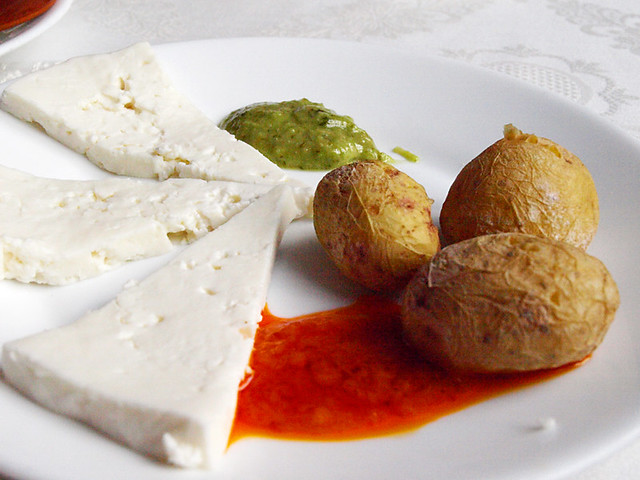Teguise is the prettiest town on Lanzarote and feels as though its maze of streets, lined by whitewashed buildings, hasn’t changed much in centuries. Mingled in with the historic ambience is a left of centre, arty scene which gives Teguise a compelling personality that sets it apart from most other towns in the Canary Islands. It’s tranquil but certainly not dull and historic whilst at the same time being bohemian in a low key sort of way.
Located in the hills above the south east coast, Teguise has a colourful historical past that should make it a prime candidate for inclusion in the next Pirates of the Caribbean movie (if there is one). Even the source of the town’s name is interesting. Teguise was the name of the last indigenous king of Lanzarote’s daughter.
The town was the capital of Lanzarote until 1852 and over the years suffered pirate attack after pirate attack. Its streets are less populated than that of the tourist resort that has taken over the role of municipality breadwinner, Costa Teguise. However, you get the feeling that every historic house has a story to tell, which is partly why it was declared a site of architecturally historic and artistic interest.
The Best of What to Do and See in Teguise
Explore Teguise on Foot
The most enjoyable part of visiting Teguise is simply to stroll around the place, snapping away at curious buildings and ducking down enticing alleys. It’s not a big town but it is packed with quaint corners and curios. A building called ‘Cine’ isn’t actually the cinema; a stone plaque on the wall with one word, Sangre (blood), identifies a street where, in 1569, the residents successfully repelled pirates intent on looting, kidnapping, torching houses and no doubt having their way with the womenfolk. Above the town, a windmill with rickety wooden spokes stands as a monument to the most important industry before tourism, the production of gofio; a toasted flour made from cereals and a staple of the Canarian diet.

Then there are the churches; the pretty Iglesia de Nuestra Señora de Guadalupe on Plaza de la Constitución dates back to the first half of the 15th century (although there have been add-ons over the years). More interesting is the 16th century Convento de San Francisco which was the first convent on Lanzarote and is now the Museum of Sacred Art.
The Pirate Museum
In all honesty, it’s not the most vibrant of museums and will probably disappoint the children as the exhibits are very text heavy. But it is located in the Santa Barbara Fort which was constructed in a commanding spot above Teguise in 1588. The fort was initially built to help see off pirates and the museum lists a who’s who of the pirates who got up to dastardly deeds on Lanzarote and the other Canary Islands. The €3 entrance fee is worth it just for the views of the volcano scarred landscape from the battlements.
(Open 9am to 4pm daily, closed Sunday)
The Timple Museum
This homage to the tiny Canarian guitar called the timple is more interesting than it might at first seem and includes variations of the timple played by different peoples around the world. Like everything else in Teguise, the museum is located in a historic building; in this case the 18th century Casa Spinola.
(Open 9am to 4.30pm Monday to Saturday and from 9am to 3.30pm on Sunday)
Where to Eat in Teguise
Coffee and Breakfast
Cafeteria Cejas (San Francisco,5; +34 928 845 101)
Cejas is located in a lovely old building. Inside are tiled floors, stained glass and a hidden courtyard. It’s perfect for a coffee and cake before exploring the town. Then again, it’s equally good for a tapas lunch and is as popular with locals as it is with visitors.
Lunch
Acatife (Calle San Miguel, 4; +34 922 845 037)
There are just loads of dangerously inviting tascas in Teguise located in old buildings, like the Palacio de Marqués or Casa Leon, where you could happily ensconce yourself for the duration instead of exploring the town. Acatife lays claim to being the first hostel on the island and has been feeding travellers for two hundred years. The menu is typically Canarian with hearty peasant dishes and chunky mojos (Canarian sauces). The cabra (goat) and local cheeses are particularly good.
Dinner
La Cantina (Calle de la Rosa, 2; +34 928 59 16 60)
One of the social hubs of the town which exemplifies the blend of historic and artistic. The food is sophisticated, the wine list plentiful, the setting with hidden courtyard is idyllic, there’s wifi, live music and they have a secret cinema to boot.
Shopping in Teguise
Arty shops are all around in Teguise making it a good port of a call for picking up something uniquely Lanzarote that isn’t tacky. Metal sculptures seem to be a thing. The big shopping day is Sunday when 300 stalls set up in town and there’s a party atmosphere. It’s the biggest tourist draw in Teguise which doesn’t suit everyone but there are local goodies to be had.
Jack is co-owner, writer and photographer for BuzzTrips and the Real Tenerife series of travel websites plus lots of other things. Follow Jack on Google+








Be the first to comment